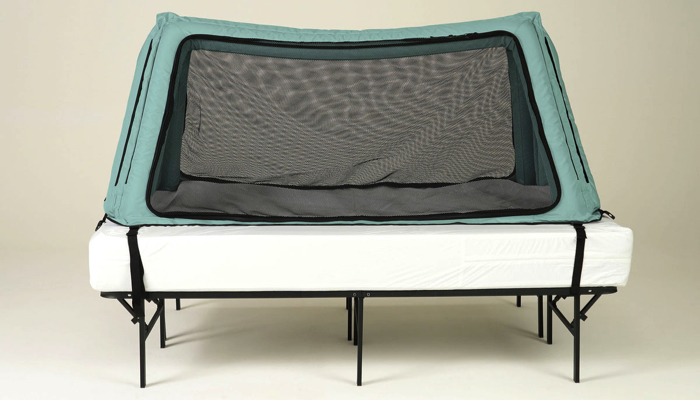Sleep Training a Toddler: The Ultimate Parent’s Guide

- Toddler sleep training aims to teach your child to fall asleep without your help.
- The best toddler sleep training method will depend on what works best for you and your toddler.
- Starting to sleep train your child sooner rather than later will help your efforts be more successful.
Imagine, it’s 8 pm and you’re ready to watch your favorite show at the end of a long day. Your toddler is laying in bed and you’re patting their back. You feel their breathing slow down and know it’s your chance to escape.
But just as you turn the doorknob and step your foot into the land of freedom and alone time—it happens. A sound erupts that lets you know the bedtime fight has begun—crying.
Getting your toddler to sleep without being held, rocked, or patted can be difficult. When they’ve grown accustomed to that extra comfort, it seems like it will never end!
What’s the solution? Sleep training.
If you’ve never heard of sleep training before, we’re here to help. Toddler sleep training is a valuable tool for exhausted parents. Many moms and dads use sleep training when their baby won’t sleep through the night or doesn’t fall asleep on their own.
If you are wondering how to get your baby to sleep without being held, sleep training may help! There are several sleep training methods and an overwhelming amount of information on the internet surrounding toddler sleep.
Don’t get lost in the web of information. We’ve created this clear, concise guide with all you need to know about creating a sleep routine and sleep training a toddler.
What Is Sleep Training?
Sleep training refers to a variety of methods that all aim to achieve one thing—better, more independent sleep for your little one.
The reason parents turn to sleep training vary. For some parents, their little one is used to nursing or rocking to sleep. This causes dependence on mom or dad for bedtime, leaving them tired and ready for relief.
Other parents have found that their child awakes frequently at night. After waking, they won’t self-soothe back to sleep.
Whatever the reason, toddler sleep training aims to teach your child to fall asleep without your help. This leaves you free to spend your evening binging tv shows, washing the dishes, or soaking in a long bath with smooth jazz serenading you.
When Should You Start Sleep Training a Toddler?
If you notice any of the following, it might be time to sleep train:
- Your toddler refuses to go to sleep without rocking, being held, etc. (Note: This is for behaviors that have been ongoing. Any sudden refusal to go to sleep should be evaluated for emotional or physical reasons for sleep refusal.)
- Your toddler wakes shortly after falling asleep and requires you to put them back to sleep. This often continues through the night.
- Your toddler is cranky and tired during the day.
- You dread bedtime and find each night to be inconsistent and stressful.
Starting to sleep train your young child sooner rather than later will help your efforts be more successful.

What Are the Best Toddler Sleep Training Methods?
The best toddler sleep training method will depend on what works best for you and your toddler. Here are 5 methods for you to explore:
1. Fading Method
The Fading sleep training method involves gradually fading out sleep associations. Sleep associations are conditions that your baby becomes dependent on in order to fall asleep. This might include breastfeeding, rocking, patting, lying next to them, etc.
Over time, you gradually reduce the time spent helping your child fall asleep. You might spend a little less time rocking your child or less time patting their back. This slow transition will help your child learn how to fall asleep on their own.
This is a gentle sleep training technique and is perfect for young babies as well as toddlers. Many parents turn to gentle sleep methods in hopes of less crying and a smoother transition. You should know that this method will take more time and patience than other methods.
2. Chair Method
The chair method sleep training involves sitting in a chair next to your toddler’s crib. Your goal is not to calm or soothe your child while sitting, but just to be present. Each night you will move your chair a little further away from your toddler’s bed until it is outside their bedroom door.
It’s important not to give your child any attention with this sleep training method. The goal is for them to recognize you are there, but to learn to fall asleep without your help.
Many parents prefer this method because it’s gentle and reassures your toddler that you are still there. However, some children might be confused as to why you are there, but not answering their calls. It’s also often difficult for parents to sit and listen to their child cry without soothing them.
Also, this might not be the best method for older children in a bed rather than a crib.
3. Ferber Method
The Ferber method of sleep training is a method that does involve more crying. Think of this as a distant cousin to the infamous cry it out method. It’s not as harsh as cry it out, but still involves periods of letting your child cry without you in the room.
To begin sleep training with this method, complete your regular bedtime routine. Then lay your child in their crib while they are still awake. Tell them “Night, night”, hug and kiss them, and then leave the room.
After leaving your child, you’ll re-enter the room after a few minutes, quickly soothe your child, and then leave again. Each time you leave, you’ll lengthen the amount of time until you return. Continue this until your toddler falls asleep.
It’s important not to return early when your child calls for you or give in and rock or pat your child to sleep. Most toddlers’ sleep issues resolve quickly using this sleep training method. You just have to be consistent and confident.
4. Pick-Up/Put-Down Method
In the pick-up/put-down method, your goal is to develop good sleep habits in a gentle way. With this method, your child will only cry for very short periods and will have your full attention and comfort.
When starting this method, you’ll lay your child down to sleep. When they start crying or fussing, you’ll pick them up and hold them until they are almost falling asleep. At this point, you can lay them back down and pick them up when they start crying again.
This cycle repeats until your child is sound asleep.
This will, no doubt, take lots of patience and hard work on the parent’s side. And some babies might become overstimulated and cranky by all of the pickings up and putting down. However, some parents still prefer this over letting their children cry.
5. Cry it Out Method
The cry-it-out method is one many parents know well. It tends to have a bad reputation and is either loathed or loved, depending on your parenting style.
It is a more aggressive form of sleep training, but typically brings faster results. For this reason, many parents, exhausted from waking in the middle of the night or tired of bedtime battles, choose this method.
To use this method, you complete your normal bedtime routine and lay your child in their crib. You then leave the room and don’t return until your child is asleep. Usually, the crying only lasts a few nights.
It’s important to know this method isn’t suitable for young babies. Be sure that your baby is old enough to sleep without night wakings for feedings before trying this method.

What Can I Do if Sleep Training Doesn’t Work?
If toddler sleep training doesn’t work, you might try looking into one of the following issues:
1. Naptime Issues
One thing that will throw off bedtime very quickly is an inconsistent nap schedule. Toddlers need to get adequate sleep during the day to help them sleep soundly at night. Though it may seem odd, more sleep does really leads to more sleep. You shouldn’t have to worry about too much sleep!
If your toddler skips nap time, they likely won’t sleep well at night. The same is true if they don’t sleep long enough during their nap.
An overtired baby is often restless. An overstimulated baby that has had too much daytime activity is often just as irritable and restless. They may take longer to fall asleep or wake frequently through the night.
Sleep training for naps might be needed if your child consistently skips naps or doesn’t nap long enough.
2. Consistent Bedtime Routine
Creating a consistent bedtime routine will help your toddler sleep train more easily. You should have a routine in place that will calm your baby and cue them that it’s time for bed.
This bedtime routine helps create a sense of security and safety. That sense of security is especially helpful during toddler sleep training.
FAQs
Should I hire a sleep coach or sleep consultant?
We know toddler sleep training can be stressful. It’s also really hard to hear your baby cry for long periods. You might be wondering if hiring someone to help is the right route.
Sleep consultants are well versed in sleep training methods and can help troubleshoot or diagnose issues with sleep patterns. Hiring one often ensures successful sleep training and takes the pressure off the parents.
However, you should know that this can be expensive depending on how much help you need. Before hiring a consultant, you might try finding a support group or asking friends for encouragement. Sometimes a little hand-holding might be all that you need.
When is it too late to sleep train a toddler?
It’s never too late to sleep train a toddler. However, sleep training does become more difficult as the child gets older.
The longer the child has certain routines in place, the harder it will be to break them of those habits. Also, older toddlers who sleep in beds will often climb out of bed instead of staying put. This will make it more challenging for the parents.
Can you sleep train a newborn?
Most experts don’t recommend starting sleep training until your baby is at least 4 months old. At this point, they are able to self-soothe and might night need the nighttime feeding any longer.

Related Posts

Sleep, Special Needs
Safe Place Bedding Travel Bed Review
Traveling with a special needs child can be stressful! Having a safe, durable, and easy to use travel bed can make traveling so much easier!

Sleep, Special Needs
Sleep Regimen for Premature Babies: Special Considerations
It can take premature babies much longer than their full-term peers to sleep for long stretches. A preemie sleep schedule may encourage better sleep.

Sleep
Mastering the Bedtime Routine: 3 Tips for a Peaceful Night’s Sleep
From around six weeks, a newborn bedtime routine can help your baby learn the difference between day and night and prepare for a restful night’s sleep.